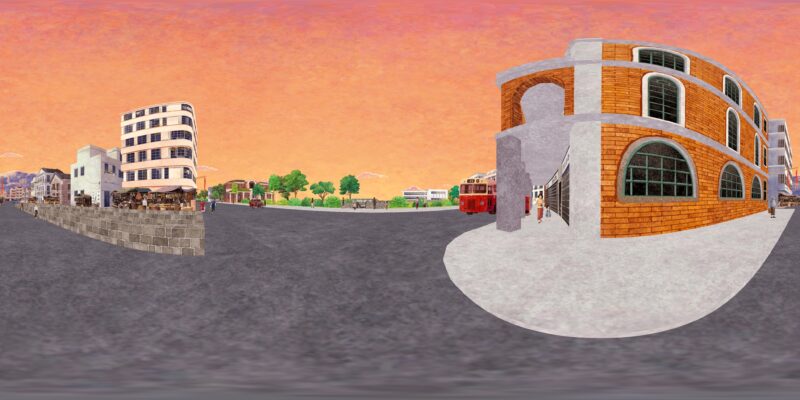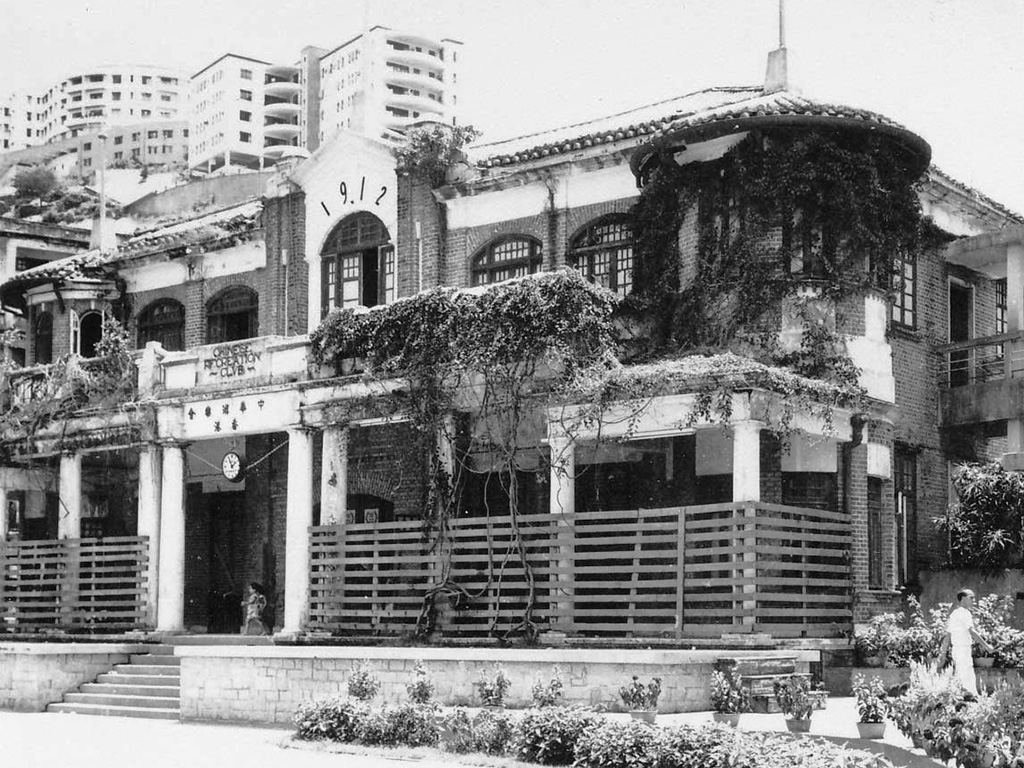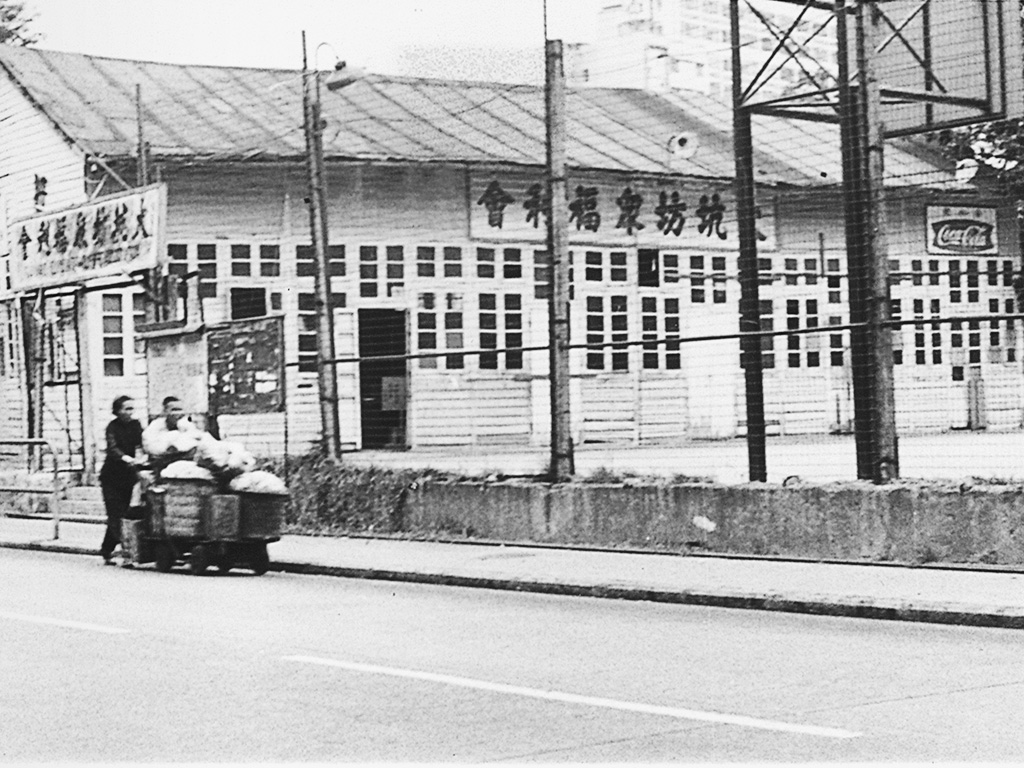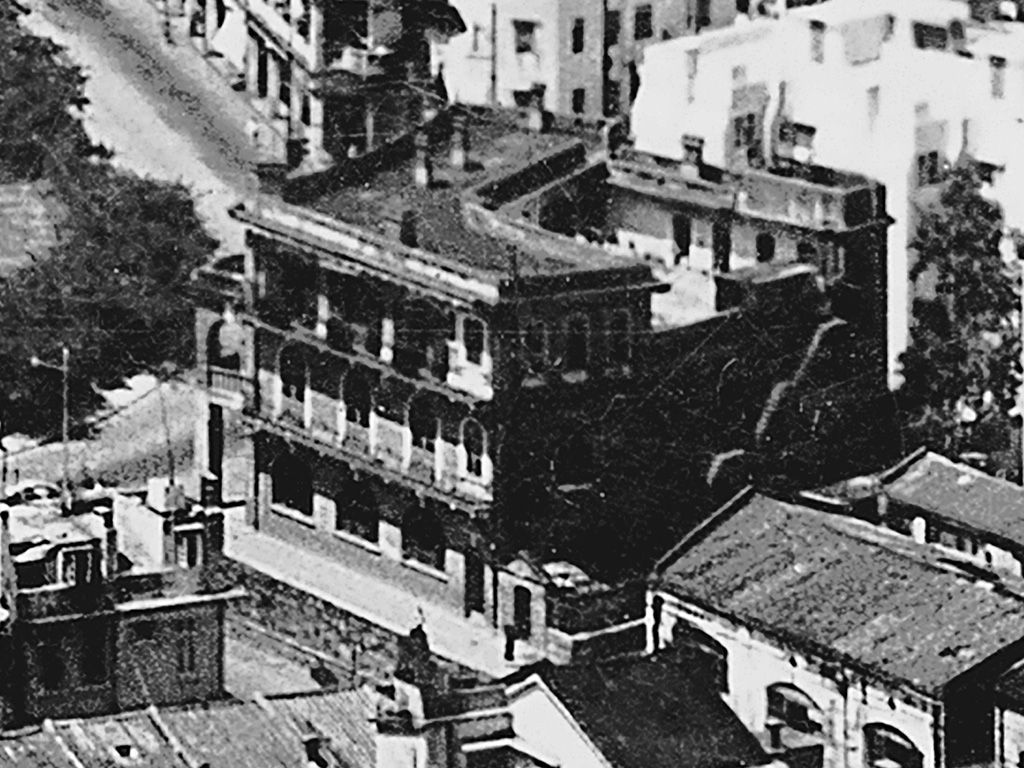Tai Hang – Tung Lo Wan Road ca.1959
Living in ca.1959

360-degree panoramic artwork created by Carmen Ng
Historical Hotspots:
Chinese Recreation Club, Hong Kong

In the 1910s, there were very few recreational clubs or facilities accepting the Chinese as members, leaving them with little chance to participate in sports and recreational activities. In view of this, Sir Ho Kai and Sir Boshan Wei-Yuk jointly applied for land grant from the government to establish a permanent club and grass court that the Chinese could use. The authorities subsequently granted land in Tai Hang, where a two-storey Victorian-style structure was built with red brick walls and a tiled roof. This became the Chinese Recreation Club, Hong Kong (CRC), which opened for service in 1912.
As one of the earliest Chinese clubs, CRC was particularly proactive in promoting tennis. In 1948, it inaugurated Hong Kong’s first Open Hardcourt Championships (currently the CRC Open). In 2024, it held its 76th competition. In its early years, one member won six consecutive Hong Kong singles championships and later represented China in the Davis Cup. This outstanding feat significantly raised the social status of the Chinese. In addition to tennis, CRC provided practice and competition venues for other sports, including cricket and football, helping to nurture a lot of local talents.
Photo courtesy of Chinese Recreation Club, Hong Kong
Tai Hang Residents’ Welfare Association

During the early stage of the Sino-Japanese War in the 1940s, the Japanese army invaded various parts of Southern China, resulting in many refugees fleeing to Hong Kong. Tai Hang became a place for temporary settlement. At the time, there were quite some severe law and order problems at Tai Hang, so the Tai Hang residents formed a “Self-Defence Group”. Members stationed daily on key routes in the community, including Tung Lo Wan Road and Tai Hang Road. The members were all resident volunteers, who received only a few dollars of nominal compensation every month. The “Self-Defence Group” was funded by Tai Hang residents, including merchants in the community.
The “Self-Defence Group” disbanded during the Japanese occupation of Hong Kong. After the war, however, crime in Tai Hang surged again due to the lack of police, causing the residents to apply from the government for re-establishing the “Self-Defence Group” and hiring armed patrols to maintain public safety. Subsequently, the community decided to form a non-profit organisation, which is known today as the Tai Hang Residents’ Welfare Association.
Once established, the Tai Hang Residents’ Welfare Association supported the neighbourhood in several ways to foster local residents’ well-being and cohesion. In the 1950s and 60s, when Tai Hang suffered from recurring fires, typhoons and floods, the Association provided natural disaster relief. Also, as the educational and recreational facilities in Tai Hang were insufficient, the Association founded Li Sing Tai Hang Primary School and arranged various recreational activities for the local residents. Later, the Association also organised the annual Fire Dragon Dance.
Photo courtesy of Public Records Office, Government Records Service
Wun Sha Street

The name “Tai Hang” is said to have originated from a waterway that ran through the area; but where exactly was this waterway? It was located on Wun Sha Street, which was once a water channel. From south to north, its waters flowed from the streams of Jardine’s Lookout and Mount Butler, down what is now Wun Sha Street and Fire Dragon Path, and eventually into Victoria Harbour. From the late 19th century, Tai Hang residents did their laundry at the upstream reaches of the waterway (now Sun Chun Street upwards). They washed everyday clothing, curtains and bedsheets, and bleached fabric in the water. They even ran laundry businesses, serving both public and private institutions, including the British army and nearby hospitals, washing a large number of uniforms and bedsheets in a very systematic way. As laundry is also known in scholarly Chinese as wun sha, the street was bestowed the name Wun Sha Street.
From the early 20th century, the middle and lower reaches of the waterway (now Sun Chun Street downwards) were modified. The curves were straightened, roadways were made along the sides for vehicles and pedestrians, and bridges were built to cross the water channel. Grocery stores, Chinese teahouses, Chinese medicine shops, food stalls (dai pai dong) and many hawkers began to do their businesses here on the street, transforming it into the centre of daily life and commercial activity in Tai Hang. In the 1960s, as the laundry industry in Tai Hang gradually declined and the road grew ever busier, the government decided to gradually cover the waterway. By the end of the 1960s, the waterway was completely covered by Wun Sha Street.
Photo courtesy of Survey and Mapping Office, Lands Department
R. Corney & Co. (Glass Merchant and Mirror Manufacturer)

Tung Lo Wan Road is one of the main transportation arteries entering Tai Hang. In the 1950s, a variety of industries established factories along the road, where raw materials and manufactured products were often moved in and out. At the intersection of Tung Lo Wan Road and Wun Sha Street at the entrance to Tai Hang stands the Ming Sun Building. This was once the site of a glass factory, R. Corney & Co., which was engaged primarily in the production of glass mirrors.
R. Corney & Co. was established by British businessman Robert Corney. He first established his factories in Australia and subsequently partnered with local Hong Kong merchants to set up production in Tai Hang due to lower labour costs in Hong Kong. R. Corney & Co. exported glass mirrors and served local commercial venues, like King’s Theatre, Queen’s Theatre, the Hongkong Hotel and the Gloucester Building in Central. However, as public demand for housing grew, and real estate values rose, the building was reconstructed for residential use in 1964. This was a fate shared by many other factories in Tai Hang during the waves of relocation in the 1960s and 70s, including a distillery that once stood on Jones Street and a plastics factory on Sun Chun Street. With the reconstruction of factories into residential buildings, Tai Hang was gradually evolved into a residential area.
Photo courtesy of The Commercial Press (H.K) Limited
Animation:

The Fire Dragon Dance has a long history of about 140 years. Performed over three consecutive nights during each year’s Mid-Autumn Festival in Tai Hang, it has always attracted numerous locals and visitors.
Started with the eye-dotting ritual for the Fire Dragon at Lin Fa Kung (which literally means the “Temple of Lotus”), the Fire Dragon Dance team festoons the dragon with burning incense sticks, followed by the parade accompanied by waves of crackling firecrackers. The Fire Dragon traverses every street in Tai Hang and performs various stunts, including “Fire Dragon Circles with Colourful Lights”, “Fire Dragon Crosses the Bridge”, “Fire Dragon Dances Around Two Poles” and “Fire Dragon-Twining Makes Pyramids”, on Wun Sha Street.
To allow more spectators to enjoy the Fire Dragon Dance, there will be a ritual of changing the dragon’s incense sticks after the first round of performance to prepare for the next performance round. Unfinished incense sticks are then distributed to the public to symbolise as bringing them peace and good fortune.